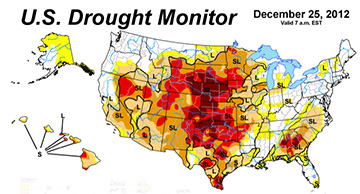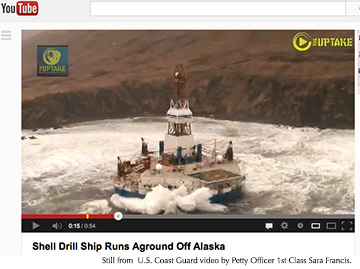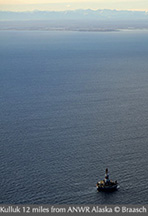Climate Photo of the Week
A New Year's surprise by Shell Oil -- and other updates on our recent climate and energy documentation. Season's Greetings from World View of Global Warming
The Shell Oil drill rig Kulluk, which Gary Braasch photographed in October off northern Alaska, broke free of tow ropes and ran aground in heavy seas while being towed to Seattle. The grounding -- one of a series of serious mistakes Shell has committed while trying to convince the US that oil drilling in the Arctic Ocean is safe -- occurred New Year's Eve near Kodiak Island in the Western Gulf of Alaska. Shell's towing vessels and the US Coast Guard had been trying to keep the Kulluk in tow during the storm for several days. Eighteen crew members of the Kulluk were rescued by the Coast Guard a day before the rig touched bottom along a rocky shore on a smaller island just south of Kodiak Island. The Kulluk has a draft of about 11 meters (35 feet).
Just three months ago on World View of Global Warming we showed how close Shell's Kulluk drilling location was to Alaska's protected Arctic National Wildlife Refuge. The grounding of the rig on its way from that location via Dutch Harbor to Seattle for the winter shows the power of Arctic weather, and the threat of oil drilling to all of Alaska's rich waters and wildlife along its coast. Environmental consultant Rick Steiner told the Alaska Daily News that "the weather encountered is not extreme and unexpected in the Gulf of Alaska in the winter - it’s just winter. This doesn’t inspire confidence in their safety and contingency planning capability.” The Kulluk is carrying about 138,000 gallons of fuel oil as it is pushed against the rocky Kodiak coast, which is a wintering site for seabirds, rich in fish and bears, and location of two archeological sites. As of January 1st, no oil has been reported leaking from the rig.
As reported by the energy news website FuelFix, "The episode provides fresh fodder to offshore drilling foes who insist that Arctic oil exploration is too risky, raises questions about the oversight of coastal voyages and casts doubt on whether Shell will be able to resume its hunt for oil underneath the Beaufort and Chukchi seas this year." For more background on Shell's sorry saga, including troubles with their other Arctic drilling ship, see the Alaska Dispatch.

The severe U.S. drought which we reported on throughout the year, particularly during a September trip through the Corn Belt, continued nearly unabated at the end of 2012 -- the driest and deepest drought in 50 years during the hottest year ever in the US. At its height the week of September 25th, 54.77 percent of the entire US was in moderate to extreme drought, according to the U.S. Drought Monitor. Now even in midwinter, drought still affects more than 51 percent of the nation. Iowa, Missouri and other more eastern states were getting more moisture, but a huge swath down from North Dakota through Oklahoma and the Texas Panhandle remained in exceptional and extreme drought for the sixth month. Looking just at the lower 48, nearly three-quarters is now still in abnormally dry or worse drought conditions, compared to more than 80 percent in mid summer. Helping create and exacerbate the drought is the persistent record-setting heat in the United States -- 2012 is the hottest year recorded since modern records began in 1895, and July was the hottest month ever.
The earth as a whole finished up the eighth warmest year on record (2010 was the warmest). December 2012 marks the 334th consecutive month with a global average temperature above the long term average. The last month with a below-average global temperature was February 1985 -- 27 year old or younger people have never experienced a below average year.
The drought has severely reduced flow in the Mississippi River, and parts of the important commercial barge route are in danger of being closed by the Corps of Engineers. The big river has been drawing down all summer and fall -- in stark contrast to the giant 500 year flood in the spring of 2011. Reporter Seth Borenstein of the AP pointed out that on May 6, 2011, the Mississippi River at New Madrid, Mo., crested at its highest point on record. Less than 16 months later on Aug. 30, 2012, the same spot on the river was more than 53 feet lower, hitting an all-time low water mark.

In a review of extreme weather and climate events of recent years, the World Meteorological Organization highlighted the unprecedented melt of the Arctic sea ice and multiple weather and climate extremes which affected many parts of the world in 2012. The reality of what is happening in the atmosphere and oceans, as the world continues to pour greenhouse gases into the air, appears to be worse than or at the maximum of mainstream scientific climate change predictions, such as those by the IPCC. More images and reporting tracking climate science and effects in Asia and North America coming up soon here.
Please see our News and Views for recent reports on the loss of Arctic Sea Ice and the American Drought of 2011 at http://www.worldviewofglobalwarming.org/pages/nvoctober0912.php
COPYRIGHT NOTICE:
Photography and text Copyright © 2005 - 2017 (and before) Gary Braasch All rights reserved. Use of photographs in any manner without permission is prohibited by US copyright law. Photography is available for license to publications and other uses. Please contact requestinformation@worldviewofglobalwarming.org. View more of Gary Braasch's photography here.




